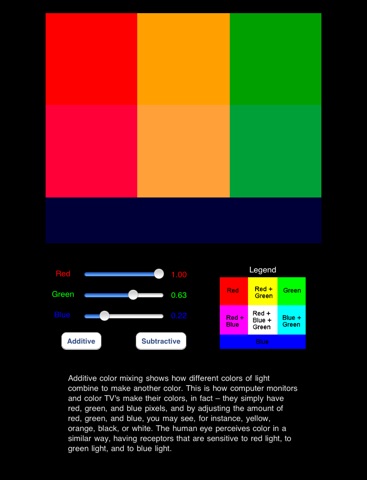
ColorMixHD app for iPhone and iPad
Developer: Andrew Duffy
First release : 30 Aug 2010
App size: 264 Kb
The ColorMix application is a simple app designed to show how you can make any color you like just by adding three colors together. The app can do additive color mixing, using red, green, and blue. It can also do subtractive color mixing, using cyan, magenta, and yellow. Additive color mixing shows how different colors of light combine to make another color. This is how computer monitors and color TVs make their colors, in fact – they simply have red, green, and blue pixels, and by adjusting the amount of red, green, and blue, you may see, for instance, yellow, orange, black, or white. The human eye perceives color in a similar way, having receptors that are sensitive to red light, to green light, and to blue light. Subtractive color mixing shows how different colors of pigments (such as paints or inks) combine. This is, for instance, how most color laser printers work. Starting with just three colors of ink (cyan, magenta, and yellow), the colors can be combined in different proportions to make different colors. Such printers usually also have a black ink, to give true blacks and to save on the ink required to make black from the combination of equal amounts of cyan, magenta, and yellow.
In the additive mode, there is a red square, a green square, and a blue rectangle. These are centered in different parts of the screen, but they overlap to give 7 distinct regions. These are red only, green only, blue only, red and green, red and blue, blue and green, and then the overlap of all three colors. You control the intensity of the red, green, and blue separately with the sliders.
The subtractive mode is similar, just with a cyan square instead of red, a magenta square instead of green, and a yellow rectangle instead of blue, with the sliders controlling the amount of cyan, magenta, and yellow. These are superimposed on a white background, instead of a black background for the additive mode. Note that, by switching from additive to subtractive, or vice versa, you get images that are negatives of one another. Its amazing how many colors and shades you can make from just red, green, and blue light, or from cyan, magenta, and yellow pigments – try for yourself.



